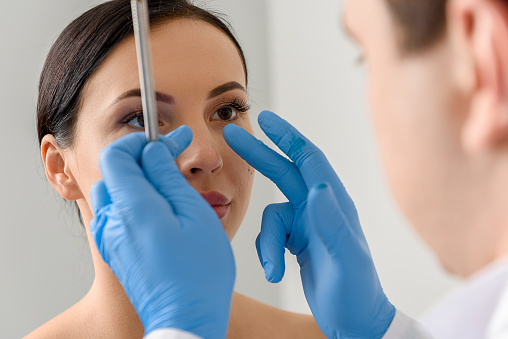What Does FFS Stand For?


Googling FFS in the dictionary yields several definitions, one of which is facial feminisation surgery. The purpose of facial feminisation surgery, also known as feminising facial surgery, is to change the masculine characteristics of the face into nonbinary or feminine traits. Facial feminisation surgery may be done as a single operation or in many stages. A classic feminine look is achieved by surgical modification of the soft tissues and bones of the face.
Furthermore, there are several procedures for doing face feminisation surgery, and several aspects must be considered when determining the most suitable solutions for every person. To learn more, keep reading.
Facial feminisation surgery (FFS) alters facial characteristics to make them look less masculine and more feminine. It could be a single operation or a sequence of surgeries. FFS can restructure soft tissue, cartilage, and bone in the face.
Masculine face characteristics are often angular and square. The procedure softens these traits, resulting in a more oval-structured face. Furthermore, the brow, forehead and ridge are adjusted to give a gentler contour with feminine accents. The jaw, nose, forehead, and hairline are the most often addressed features with FFS.
FFS could be part of a larger strategy of gender identification, matching a person's body and face with their gender. The treatments may also be acceptable for cisgender women who want more feminine facial characteristics or gender nonbinary persons who wish to seem more feminine.

Your medical provider will thoroughly examine before performing face feminisation surgery. They will question you regarding your surgical objectives and discuss what you may anticipate throughout your recovery. It is critical that both you and your doctor establish matched and attainable goals.
Your physician additionally ensures your overall fitness by:
Evaluating your everyday habits, mainly smoking and alcohol intake.
Performing a physical examination, such as laboratory work.
Detecting probable problems and dangers.
Examining your previous drugs as well as any sensitivities you could have.
Before having face feminisation surgery, you may also undergo imaging examinations. CT scans and X-rays are images of your skull and face. Your doctor could also assess your face, take pictures, and evaluate your skin condition. This data assists your doctor in planning your therapy.
Everybody's experience with facial feminisation surgery is unique. The procedure is determined by the facial traits you want to alter. You could have one or more surgeries, such as:
Shrinking hairlines are much more common in males than in females. Your doctor could create a cut over your hairline and move your skin forwards through your brow, maintaining healthier hair follicles and allowing the growth of your hair. Male-pattern baldness may also be treated by hair transplant surgery.
Your doctor could surgically eliminate a portion of this bone and restructure it to make it seem smoother.
Females have higher cheekbones and greater cheek fats. Your doctor could use fat injections or silicone implants to enhance your cheeks. They could extract fats from another part of your body, like your legs.
Your doctor could narrow your nose by eliminating and altering the bone. Throughout rhinoplasty, doctors also may remodel the tip and bridge of your nose to give it smooth curves and a delicate, feminine point.
Females' upper lips are typically bigger and nearer to their noses versus men's. Via a tiny incision beneath your nostrils, your doctor may elevate the height of your upper lip. They could also use fillers or fat injections to make your lips bigger.
Men have bigger, squarer chins. Your doctor could lower the size and contour of your chin to make it more oval or pointy. Chin reshaping is sometimes referred to as genioplasty.
Men, like women, possess broad, square mouths. Your doctor may take away segments of bone via an incision within your mouth to lessen the size and acute corners of your jaw. You will not have a noticeable scar due to this sort of surgery.
Males have bigger Adam's apples where the tracheal cartilage sticks in the front of your throat. A tracheal shave is performed by a doctor who makes an opening beneath your chin and cuts away a portion of the cartilage.
A full FFS may require eight to nine hours when performed as a single procedure. Other doctors propose separating the treatments into two operations, spaced by seven to 10 days or more. Having two separated operations offers your face greater time to recover from surgery.
You will wear bandages or gauze over your wounds for many days. To relieve irritation, apply compression bands over your jaw or brow. You could also be sent home with a medical drain. A drain is a tiny plastic tube inserted into your skin by the physician. It aids in the drainage of fluid and blood, hence preventing oedema.
Your doctor will most likely eliminate the nonabsorbable sutures a week following your operation, or they could insert absorbable sutures, which are not required to be eliminated. However, even after the stitches are gone, your face will be needed to mend for many weeks before the outcome is evident.
Definitely don't overwork yourself, especially in the first two weeks. Facial feminisation surgery is a big operation. You must maintain your head raised for at least two weeks following the procedure. Lowering over and performing anything which increases your blood pressure or heart rate should be avoided. For the next two weeks, prevent lifting anything more than 20 pounds. Moderate walking is permitted shortly following your surgery. Exercising and other vigorous hobbies may be continued for four weeks following surgery.
It's ok to begin taking showers two days following your surgery. Essential water and soap are enough. Administer antibacterial ointment to any cuts three times each day for seven days. For one month, prevent using any harsh hair treatments or skin care. Following your face feminisation procedure, you can expect to feel bruised and swollen. Because the face is so vascular, this is quite natural. The bulk of your inflammation and bruises will diminish within two weeks, with the most severe symptoms occurring two days after surgery.
You will be given a powerful pain reliever that most individuals employ for 3 to 7 days. Several people tolerate ordinary Tylenol following their FFS, but most require more. You will also be given a 7-day prescription of oral medications and an antibacterial mouthwash if some verbal cuts are made. For the next two weeks, prevent using any NSAIDS because they may induce bleeding.
Arnica montana is an over-the-counter botanical drug that may be administered 14 days after surgery to minimise bruising and oedema. This drug must be started the day before the operation. Before sending you home, all medicines and post-op directions will be thoroughly discussed.
Face feminisation surgery may assist you in achieving the physical look of the genders you associate with. Several individuals changing from male to female see this as a vital phase in the procedure. You could feel more at ease and confident in your sexual identity following surgery.
Destruction of the nerves in the chin or jaw. This may lead to irreversible loss of sensation and functionality in the tongue and face.
Infections induced by implantation in the cheek and chin.
Nerves might also be cut in the scalp surgery. However, most patients recover the majority or all of their scalp skin feeling as they recuperate.
When deciding on brow and lip fillers, be extremely careful of lifelong fillers, including silicone. As your facial expressions alter with age, soluble fillers enable you to adjust the look of your soft tissue.
When you have any of the following issues after your operation, notify your medical professional straight away:
Signs of infection, such as inflammation or drainage, pain, and redness
Shortness of breath
Chest pain
Arrhythmia

Everyone's gender experience is unique. Although some people believe that face feminisation surgery must be validated their identity, others do not. Whatever your motivation for seeking face feminisation surgery, seek referrals to a competent board-certified cosmetic surgeon. Consider that not everybody understands femininity the same way, so thoroughly discuss how your surgery plan matches your goals with your physician.










Plus get the inside scoop on our latest content and updates in our monthly newsletter.